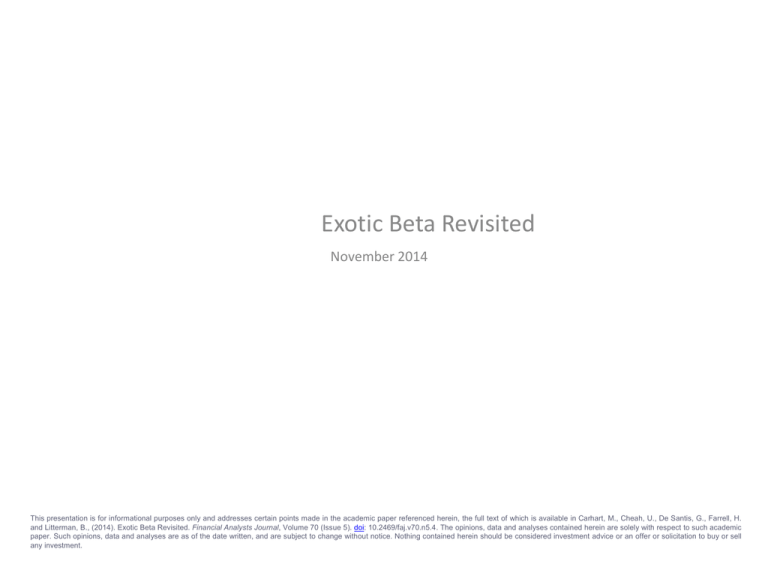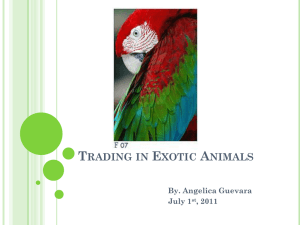Kepos Capital LP
advertisement

Exotic Beta Revisited November 2014 This presentation is for informational purposes only and addresses certain points made in the academic paper referenced herein, the full text of which is available in Carhart, M., Cheah, U., De Santis, G., Farrell, H. and Litterman, B., (2014). Exotic Beta Revisited. Financial Analysts Journal, Volume 70 (Issue 5). doi: 10.2469/faj.v70.n5.4. The opinions, data and analyses contained herein are solely with respect to such academic paper. Such opinions, data and analyses are as of the date written, and are subject to change without notice. Nothing contained herein should be considered investment advice or an offer or solicitation to buy or sell any investment. Outline 1. A Taxonomy of Exotic Betas 2. Empirical Evidence on Exotic Betas 3. Comparing Alternative Risk Premium Approaches 4. A Dynamic Portfolio of Exotic Betas 5. Closing Remarks Challenge of Policy Allocation Conventional Approach Capital-Based Allocations Challenge: Allocation decisions reflect unintended factor exposures Proposed Solution: Asset Classes Purposeful and explicit allocation to risk premia Better knowledge of return sources Risk Premia Themes Risk Factor Approach Multiple Risk Premia within Asset Classes The Return Spectrum “…returns exist along a continuum – from beta, to exotic beta, and ultimately to alpha.” – Litterman (2005) Alpha Beta • • Macro statistical arbitrage Exotic Beta • Volatility arbitrage • Long term value • Systematic events • Income • Long term momentum • Insurance Global equities Passive Active Lower cost Higher cost Well-known Proprietary A Taxonomy of Risk Premia We focus on four risk premia themes across all four major asset classes. ASSET CLASSES Equities Value Income RISK PREMIUM THEMES Insurance Momentum Bonds Currencies Commodities Cheap assets tend to outperform expensive assets Investors demand additional yield for lower volatility assets Risk averse investors pay a premium to insure against extreme events Asset performance can be persistent Building an Exotic Beta Portfolio 1 Choose a carry measure 2 Construct a 3 Hedge away dollar-neutral FX portfolio on carry rank ACWI beta using liquid equity index futures FX Carry Portfolio 3-Month LIBOR -100 -50 0.0 1.0 2.0 3.0 4.0 0 FX Carry Portfolio 50 100 -100 Australia New Zealand New Zealand Canada Australia Australia Euro Norway Norway Japan Canada Canada New Zealand Sweden Sweden Norway United Kingdom United Kingdom Sweden United States United States Switzerland Euro Euro United Kingdom Japan Japan United States Switzerland Switzerland ACWI - Hong Kong ACWI - Japan ACWI - Eurostoxx 50 ACWI - United Kingdom ACWI - United States -50 MSCI ACWI Hedge 0 50 100 Comparing Theoretical and Tradable Exotic Betas Tradable Exotic Beta Portfolios are obtained as follows: • Use only tradable assets (e.g. liquid futures contracts) • Penalize tracking error from theoretical Exotic Beta portfolio • Charge for transaction costs Distribution of Equity Beta Estimates for Exotic Beta Portfolios 1.50 1.50 1.00 1.00 0.50 0.50 0.00 0.00 -0.50 -0.50 -1.00 -1.00 Historical Evidence: ACWI and Individual Exotic Betas Key Takeaways All portfolios are normalized to 10% target volatility 1. Attractive potential returns 2. Low cross-correlation 3. Poor performance does not correspond with poor performance in equities Summary Statistics for Exotic Beta Portfolios Sampling period: January 1990 – December 2012 Return Correlations for Exotic Beta Portfolios • • Average correlation is 0.04 Using three-year window estimates: - Average correlation is between -0.04 and 0.10 - Less than 7% of all the correlations are larger than 0.35 (in absolute value) Cumulative Excess Retruns: ACWI and Equal Risk Exotic Beta Portfolio LTCM blow up and tech bubble 1994 run-up in sovereign bond yields Risk Parity Main idea: • Scale investment in different asset classes to the same risk • Combine scaled asset class investments into an equally weighted portfolio Risk Parity (Across Asset Classes): Return Correlations • • Average correlation is 0.23 Using three-year window estimates: - Average correlation is between 0.12 and 0.36 - More than 25% of all the correlations are larger than 0.5 (in absolute value) Understanding Implied Views The common idea that the risk parity portfolio has no views on expected returns is a misconception Comparing Alternative Investment Strategies The exotic beta portfolio offers • Better return/risk profile • Less extreme DD/vol • More attractive diversification Can we explain exotic beta returns? Conditional alpha is almost identical to unconditional alpha for the exotic beta portfolio Risk parity and hedge funds explain very little of the return variation in the exotic beta portfolio Estimated Premiums and Correlations Most realized returns are biased, due to overfitting, unusual circumstances, survivorship and backfilling bias, etc. We use the Black-Litterman model to shrink historical returns towards a CAPM equilibrium Some correlations are high, due to a common ACWI exposure Efficient Frontier and Risk-Return Trade-Offs 6% Exotic Beta 28% Global Bonds 39% Hedge Funds 33% Exotic Beta Black-Litterman Expected Excess Return 5% Risk Parity Optimal at Bond Vol 4% Hedge Funds Maximum Sharpe Ratio 60% Global Equities 40% Global Bonds 37% Global Bonds 37% Hedge Funds 26% Exotic Beta 3% Global Equities 60/30/10 60/40 60% Global Equities 30% Global Bonds 10% Hedge Funds Global Bonds 2% 1% 0% 2% 4% 6% 8% 10% Volatility 12% 14% 16% 18% Risk Budgeting: Out of Sample Evidence 2005 Max SR Portfolio 2008 Max SR Portfolio 41% Hedge Funds 38% Exotic Beta 21% Global Bonds 42% Hedge Funds 35% Exotic Beta 23% Global Bonds Outline 1. A Taxonomy of Exotic Betas 2. Empirical Evidence on Exotic Betas 3. Comparing Alternative Risk Premium Approaches 4. A Dynamic Portfolio of Exotic Betas 5. Closing Remarks Exotic Beta Portfolio: Equal-Risk vs. Dynamic-Risk Allocations Equal-Risk Exotic Beta Portfolio • Uses only backward-looking estimates of volatilities and correlations • Targets 10% volatility • Rebalances on a monthly frequency • Incorporates t-cost penalties Dynamic-Risk Exotic Beta Portfolio • Same as Equal-Risk Exotic Beta Portfolio • Incorporates conditional views on the risk premiums based on: − Prior − Historical means − Value − Momentum − Spillover (Market Disruption) • Imposes penalties on position and trade size Conditional Forecasts of an Exotic Beta: Currency Carry 2.0% 1.0% 0.0% Prior Historical Mean Value Momentum Spillover Dec-12 Jun-12 Dec-11 Jun-11 Dec-10 Jun-10 Dec-09 Jun-09 Dec-08 Jun-08 Dec-07 Jun-07 Dec-06 Jun-06 Dec-05 Jun-05 Dec-04 Jun-04 Dec-03 -1.0% Exotic Beta Portfolio: Equal vs. Dynamic Risk Allocation STATISTIC Average Excess Return Annualized Volatility Sharpe Ratio Maximum Drawdown MaxDD/Vol Correlation with ACWI Equal Risk Dynamic 14.6% 19.2% 10.4% 9.5% 1.41 2.03 -21% -14% (2.0) (1.4) 0.21 0.13 Average Marginal Contributions to Risk: Equity Value 13.1% Bond Yields 9.6% Bond Slope 7.2% Commodities 9.3% Real Assets 13.0% Currency Value 10.9% Volatility 11.6% Credit 15.3% Catastrophe Bonds 10.1% 13.5% 10.3% 5.5% 13.6% 9.7% 24.1% 18.4% 3.1% 1.8% Marginal contribution to risk from timing model is 27% Average turnover of the Dynamic portfolio is 9 months Outline 1. A Taxonomy of Exotic Betas 2. Empirical Evidence on Exotic Betas 3. Comparing Alternative Risk Premium Approaches 4. A Dynamic Portfolio of Exotic Betas 5. Closing Remarks









